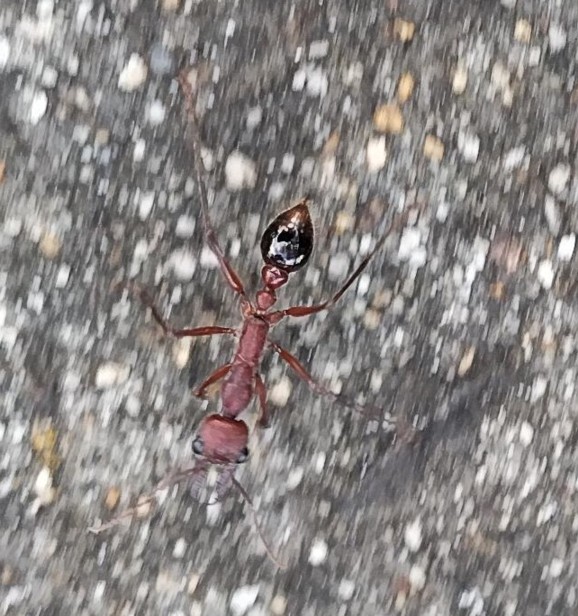ANTS at WESTERN COVE
Order — Hymenoptera;
Family — Formicidae
About 15,000 species of ants are known worldwide including 3,000 species (in 100 genera) in Australia.
Below is an informal report about some of my encounters with ants at Western Cove.
RED ANTS (Myrmica rubra)
Nests of common red ants are common at Western Cove. These ants are red in colour and about 1 centimetre long. Their nests occur mainly in the firm soil alongside roads rather than the sandy soil elsewhere. Disturb the nest entrances and ants come pouring out.
While out for a walk one night I paused to look up and identify some stars and soon felt crawling sensations on my legs. I hurried home and cleared out about 30 red ants from my pants. However, I received no bites and all was well.
Ants impact environments through nest building, scavenging, and killing other insects. These activities influence the level of nutrients in soils, the mixing of soils, and the populations (or presence or absence) of other insects, spiders, and animals.
Red ants have established a colony near my house. I’m leaving them there in the hope they’ll help to keep the house ants away — see next section:
HOUSE ANTS
"House ants" are dark-coloured, 2 to 3 millimetres long, and walk between nests in long trails dozens of metres long. They nest under loose bark in trees and tree stumps, and in any small, enclosed, sheltered space.
For 15 years house ants inhabited the walls of my house and would rapidly congregate on exposed food on tables and elsewhere. Applying surface-insecticide around the house and footings, and the underside of floors, deterred them for only a few days since the ants inside the walls survived and soon re-established contact with their relatives outside.
Finally I removed parts of the exterior cladding of the house, wherever the ants seemed active, and pulled out the insulation, and sprayed insecticide inside the walls. In several areas inside the wall the ants seemed to number thousands.
After clearing out the ants from inside the walls the application of Defender Outdoor Barrier Spray every few months around and under the house has controlled the problem.
RED BULLDOG ANT (Myrmecia)
These are the biggest ants at Western Cove, almost 2 centimetres long.
Entomologists consider Red Bulldog ants "primitive" since their social organization is relatively simple. They are aggressive, wander around as solitary hunters, adopt an immediate fighting stance when disturbed, and inflict painful bites with their mandibles.
I had never encountered them or their nest until one day when I sawed some branches off a sheoak 50 metres from my house. Suddenly, in rapid succession, I felt six painful stings on my left foot and heel. By nightfall intense itching supplemented the pain, and the foot was becoming increasingly swollen or puffy.
No lotion or cream I had available reduced the itch and sleep was impossible. I therefore adapted and tried out a treatment which I had discovered to be effective against sand-fly bites (another Western Cove annoyance).
To control the itch from sandflies I hold the bite-sites, consisting of red circles rarely more than 1 centimetre across, close to a candle flame until the pain of the heat overcomes the itch. One such treatment, or sometimes two or three in severer cases, stops the itch. (It works with mosquito bites too!) Anti-itch preparations from the pharmacy are less effective and also have to be applied repeatedly for several days. Also ineffective is scratching, since this can produce sores that take weeks to heal!
The bites of the bulldog ants effected my whole foot and required more than a candle flame. Therefore I heated each side of the foot at my wood-burning stove until the itching on each surface stopped. After that I plunged the foot into cold water. This was in winter and the water was cold. The procedure was effective and stopped the itch and pain about two hours each time. I'm not, however, advising anyone to follow these procedures; if you experience similar problems get medical advice from professionals.
The swollen foot remained unchanged for four days; and at nights I repeatedly gave it the heat treatment. The puffiness did not advance higher than the ankle, and after four days began to slowly subside, but required more than another week to disappear.
Lately I've regularly encountered solitary bulldog ants wandering on my property. One dropped a dead beetle it was carrying, adopted its fighting stance (body elevated, head raised, and mandibles wide open), and advanced toward me. After I backed away the ant ceased its pursuit of me, retrieved the dead beetle, and continued to its destination.
Nowadays, at Western Cove, whenever I stand in one location for any reason I check the ground around my feet.
BLACK ANTS
I’ve also noticed nests of black ants (possibly genus Lasius) near my house at Western Cove. These are larger than the house ants, smaller than the red ants, comparatively few in number, and have never annoyed me.
TERMITES
Termites although often called "white ants" are not ants. The mounds they build as in the photo below are common at Western Cove.

